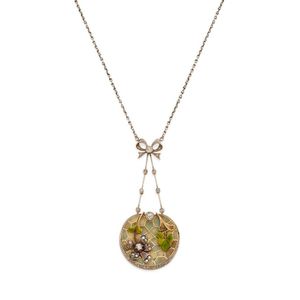Art Nouveau Diamond Pendant Necklace with Plique-a-Jour
An Art Nouveau plique-a-jour and diamond pendant necklace suspended from a bow garland, the pendant with floral motif set with old mine and single-cut diamonds on a plique-a-jour ground, accented with rose-cut diamond detailing, mounted in platinum and 14ct gold, pendant length 5.50 cm, necklace length 46.00 cm. Accompanied by fitted box.
You must be a subscriber, and be logged in to view price and dealer details.
Subscribe Now to view actual auction price for this item
When you subscribe, you have the option of setting the currency in which to display prices to $Au, $US, $NZ or Stg.
This item has been sold, and the description, image and price are for reference purposes only.
- Plique-A-Jour - Plique a jour, which translates from the French as ?glimpse of daylight? is a method of enamelling in which the backing is removed or cut away so the light shines through, with a similar effect to a stained glass window. The enamel is held in place by border.
Although the technique of plique-a-jour has been known and in use since the 6th century, it became popular again in the late 19th century, in Russia and Scandinavia. Plique-a-jour was popular in the Art Nouveau period, especially for jewellery.
Because of the length of time required to produce an item, and the high failure rate, production was limited, and the technique is little used today. - Floral Swag / Garland / Festoon - Floral swags are a decorative motif often used in the ornamentation of various objects, such as silverware, glassware, and furniture. The term "swag" refers to a garland or wreath of flowers, foliage, or other decorative elements, which is usually arranged in a loop or curve.
Floral swags can be found in a variety of decorative styles, from ornate Baroque and Rococo designs to more naturalistic Art Nouveau and Art Deco styles. They are often used to add a touch of elegance, refinement, or whimsy to an object, and can be seen on a range of items from chandeliers and candlesticks to picture frames and tea sets.
In the decoration of silver objects, floral swags are often used to accentuate the curves and lines of the piece, and to add visual interest to the surface. Similarly, on glass objects, floral swags may be used to frame or highlight a particular area of the object, or to add a touch of color and delicacy.
On furniture, floral swags can be found on a variety of pieces, from cabinets and armoires to chairs and sofas. They are often used to enhance the lines and curves of the furniture, and can be used to create a sense of movement and flow in the design.
Overall, floral swags are a versatile decorative element that can be adapted to a range of styles and applications, and have been used in the decoration of various objects throughout history. - Art Nouveau Period - The Art Nouveau period was a cultural movement that emerged in the late 19th century, and was characterized by its emphasis on natural forms, flowing lines, and a decorative, ornamental style. Art Nouveau was a reaction against the ornate and heavily stylized designs of the previous era, and sought to create a new, more organic aesthetic.
Art Nouveau was characterized by its use of sinuous, curving lines, as well as a focus on natural elements such as flowers, vines, and other organic shapes. Art Nouveau designers sought to create a total work of art, in which every element of a building or object was designed to be harmonious with the overall design.
Some of the most iconic examples of Art Nouveau design include the Paris Metro entrances designed by Hector Guimard, the works of the artist Alphonse Mucha, and the architecture of Victor Horta in Brussels.
The Art Nouveau period was at its peak between 1890 and 1910, but began to decline in popularity by the start of World War I. However, Art Nouveau remains an important influence on design and art to this day, and continues to be celebrated for its emphasis on natural forms and decorative style. - Rose Cut - A flat based cut for a preious stone, leaving the surface covered with triangular facets, usually 24 in total.
It was introduced in the 15th century and popular during the 16th and 17th centuries.
The rose cut was the most popular form of diamond cut until the discovery of the brilliant cut at the end of the 17th century, after which its use declined.
This item has been included into following indexes:
